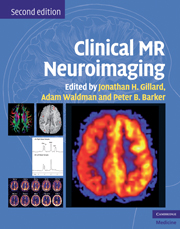Book contents
- Frontmatter
- Contents
- Contributors
- Case studies
- Preface to the second edition
- Preface to the first edition
- Abbreviations
- Introduction
- Section 1 Physiological MR techniques
- Section 2 Cerebrovascular disease
- Section 3 Adult neoplasia
- Section 4 Infection, inflammation and demyelination
- Section 5 Seizure disorders
- Section 6 Psychiatric and neurodegenerative diseases
- Section 7 Trauma
- Section 8 Pediatrics
- Section 9 The spine
- Index
Preface to the first edition
Published online by Cambridge University Press: 05 March 2013
- Frontmatter
- Contents
- Contributors
- Case studies
- Preface to the second edition
- Preface to the first edition
- Abbreviations
- Introduction
- Section 1 Physiological MR techniques
- Section 2 Cerebrovascular disease
- Section 3 Adult neoplasia
- Section 4 Infection, inflammation and demyelination
- Section 5 Seizure disorders
- Section 6 Psychiatric and neurodegenerative diseases
- Section 7 Trauma
- Section 8 Pediatrics
- Section 9 The spine
- Index
Summary
Preface to the first edition
The advent of clinical MR imaging (MRI) in the 1980s heralded a new era in the ability to image the brain in vivo. MRI allows the detailed depiction of brain anatomy and pathology with unprecedented spatial resolution and soft-tissue contrast. It is also relatively safe and completely non-invasive. Nevertheless, the sensitivity and specificity with which structural MRI alone can define the wide range of neurological disease is limited.
The last decade has also seen the development of physiological MR techniques, whereby information concerning tissue function as well as structure is obtained. These techniques include diffusion, perfusion, and MR spectroscopy, which provide information on tissue ultra-structure, blood flow, and biochemistry, respectively. Information of this type supplements and complements that from clinical or structural imaging investigations, often providing important surrogate markers of disease pathophysiology or therapeutic response.
- Type
- Chapter
- Information
- Clinical MR NeuroimagingPhysiological and Functional Techniques, pp. xixPublisher: Cambridge University PressPrint publication year: 2009

